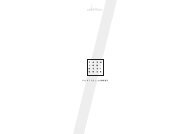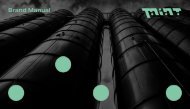Patterns in Nature, editorial design project by our 2nd-year student Ellen Andersin.
“Patterns In Nature”. A glimpse into the world of phenomenal natural patterns Editorial design project by our 2nd-year student Ellen Andersin. Marbella Design Academy - Spain – Founded 1995 - Tuition in English
“Patterns In Nature”.
A glimpse into the world of phenomenal natural patterns
Editorial design project by our 2nd-year student Ellen Andersin.
Marbella Design Academy - Spain – Founded 1995 - Tuition in English
Create successful ePaper yourself
Turn your PDF publications into a flip-book with our unique Google optimized e-Paper software.
2 3<br />
Waves are spread throughout nature and carry<br />
energy as they move. Sound waves are vibrations<br />
of the air (4), while light is a wave of oscillat<strong>in</strong>g<br />
electrical and magnetic fields, mov<strong>in</strong>g through<br />
space faster than anyth<strong>in</strong>g else. Collid<strong>in</strong>g waves<br />
may re<strong>in</strong>force or cancel out one another, depend<strong>in</strong>g<br />
on whether they are <strong>in</strong> or out of step. Interference<br />
of light waves may result <strong>in</strong> spectacular colors,<br />
like soap or oil films on water. When sound waves<br />
are restricted to a fixed space, like an <strong>in</strong>strument,<br />
certa<strong>in</strong> frequencies and patterns may be picked<br />
out <strong>in</strong> the phenomenon of resonance. The 18th<br />
century scientist and musician Ernst Chladni<br />
discovered that it is possible to create <strong>in</strong>terest<strong>in</strong>g<br />
patterns of scattered f<strong>in</strong>e gra<strong>in</strong>s (2), lay<strong>in</strong>g on<br />
a metal plate, only from sound wave vibrations<br />
when draw<strong>in</strong>g a viol<strong>in</strong> bow across the edge.<br />
Sea surface waves create a chaotic pattern on<br />
water, driven <strong>by</strong> w<strong>in</strong>d waves. As waves <strong>in</strong> water or<br />
w<strong>in</strong>d pass over sand, patterns of ripples appear (1),<br />
and if bigger, dunes are created. Different patterns<br />
form <strong>in</strong> dunes when the w<strong>in</strong>d arranges sand gra<strong>in</strong>s <strong>in</strong>to<br />
regular structures; crescents, long l<strong>in</strong>es, stars, domes<br />
or parabolas, and they may look very different from<br />
another. These self organiz<strong>in</strong>g patterns are based on<br />
the particular speed of the w<strong>in</strong>d and the average gra<strong>in</strong><br />
size. This is why dunes on other planets, let’s take Mars<br />
as an example (3), may also have similar dunes but form<br />
patterns not possible on Earth. The different conditions<br />
affect the ways the gra<strong>in</strong>s are transported and how they<br />
bounce; the gravity is weaker or Mars, the atmosphere<br />
is th<strong>in</strong>ner and the w<strong>in</strong>ds can be much faster.<br />
4<br />
13 Waves & Dunes

















